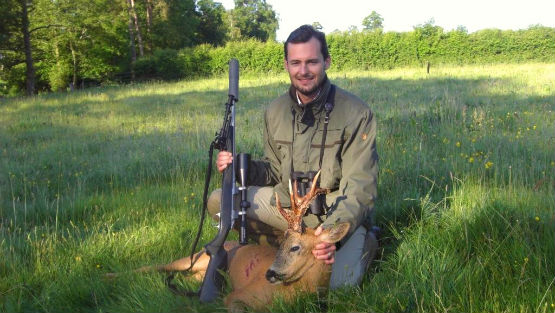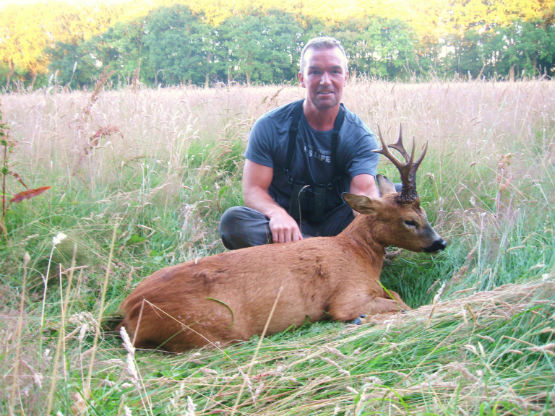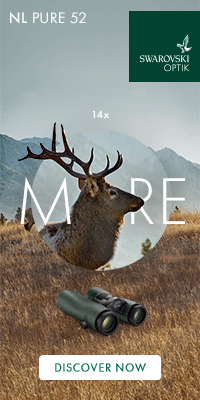Senior CIC International Trophy Measurer Iain Watson, looks at a perennial question with no easy answer. When is it best to stalk Roebuck?
The reality that prey animals face times where danger is heightened, is widely recognised. While risk will be moderated by the activities of the predator, rising and falling as daylight comes and goes, changing with its feeding patterns, and altering with the seasons, for the hunted, risk is a life constant, which has to be adapted to.

(Above: A Medal Class Roe Buck shot in early May with 'County Deer Stalking' - showing antlers clearly still in 'tatters' and light in colour)
But along with “natural” risk, statistically, if you happen to be a roebuck, the most lethal day of the year you face appears to be April the 1st, closely followed by the next 20 days of that month.
Our national trophy records, maintained by the CIC over the past half century, point not only to the huge increase in the numbers of quality roe in our country, but also towards a bias of early shooting of medal class animals. Overall numbers culled in the first three weeks of April far outstrip those coming from other months, of what is, after all, a long season. The records illustrate that the fall off in numbers can be quite startling, slowing through May and June, with a bit of a pickup in the rut, then reducing as summer fades and autumn approaches.
Is this the most effective way to manage our trophy resource from both the conservation, commercial and recreational perspective?
Certainly early spring days provide a brief window, which rapidly closes as the days lengthen and the cover springs up. Deer are easier to see, and therefore vulnerable to stalking pressure. Bucks can be found prospecting for future territories and does looking for a return to preferred home ranges. The foolish young are forced to find their feet and make the often-fatal mistakes that young do. This period provides us with an opportunity to take stock of our residents and to look at them in relation to overall sex ratios and physical condition. Partly as a result of the antipathy felt by some towards the late shooting of pregnant does, the real state of local populations can often be miscalculated, resulting in assumptions being made which can cause problems in the long run.

(Above: A Medal Class Roe Buck shot with 'County Deer Stalking' at the end of July during the Rut - Antlers clean of velvet and well coloured)
I recently found myself called in to undertake a cull in a Scottish low ground wood, used to release pheasants by a do it your-self syndicate. The syndicate like many, had a stalking section, and its self appointed deer manager had decided that following a survey undertaken by him in spring 2012, no females were to be shot. The survey had clearly missed something. The net result of his decision, coupled with some immigration was population growth that had reached alarming proportions. Animals were in unacceptably poor physical shape with only one mature buck apparently living in the wood. The resultant cull of a high percentage of the counted female population showed poor pregnancy levels amongst adults as well as high parasite burdens.
However, back to the bucks. Purely from a trophy perspective there are no doubt pros and cons to early season shooting. Sure the bucks are easier to locate, but more often than not they lack colour or in extreme cases have to be stripped of residual velvet prior to being evaluated. Both disadvantage the final score. On the up side, pearling and coronet definition tends to be fresher and sharper which might balance the lack of colour. But an often-overlooked aspect is the core condition of the antlers and therefore the overall impact on weight and volume, the two most critical elements in the scoring of roe trophies.
When cleaned of the velvet, and as they colour up, antlers develop a surface finish, in effect a seal. This process has an impact on the final weight of the trophy. At the same time the core of the new antler continues it’s drying out process, in effect going through a process of some internal shrinkage. All of these aspects have an effect on the final score resulting in silvers that should have made gold.
But trophies apart, from the conservation and management perspective, there are a number of areas that the deer manager may want to consider, before an early harvesting of the mature bucks. March and April can prove to be hard months for deer. At the end of a long winter, body resources can be low, and health fragile. If stock conservation and long term population structure are recognised as being part of the management plan, are there really benefits to potentially destabilising this by taking out mature established members? To do so will surely only open the door to territorial spats, an invasion of youngsters, and increased damage as they exert themselves while exploiting the vacancies.
An argument I often hear is that by spring trophy bucks will have already passed on their genes at last year’s rut. Quite so, though while it has to be true that the females covered by them may produce offspring that will carry at least 50% of their genes, it might not be so easy to predict if those yet to be born will inherit from the male parent, those characteristics which have made him great. Having taken him, will the benefits he brought be matched by the genes his replacements bring? It may be prudent at this stage in the season to leave the mature members of the population, thus encouraging group stability, and concentrate your efforts in harvesting the poorer members of the latest generation, and the infirm.
Then there has to be the critical question…. has your potential trophy animal reached its zenith or if left this season, and maybe next, will it be better? The answer is often yes.
Talking to roe enthusiasts there seems to be a pressure amongst new comers to the sport to be seen to have shot a medal head. No doubt, for many, doing so brings a lot of pleasure and a sense of achievement. However the action of leaving the animal till later in the season might well be found to have a much greater benefit in the long run, along with a considerably improved trophy when nature has polished and burnished the head to its full glory.
For more on how to measure a Roe Buck Trophy follow this link: how-to-measure-a-trophy
Or to read more from Iain Watson about the CIC and it's measuring system click here: the-cic-and-it-s-trophy-measurement-system
Iain Watson is CIC Senior International Trophy Judge and Expert to the UK Delegation of the CIC. He has been involved in trophy measuring since the mid-1980's .
For more on Roe Buck Stalking follow this link: roe-buck-stalking
Or contact us on: 0203 981 0159 /



















